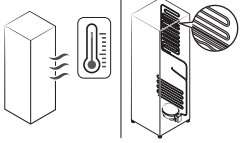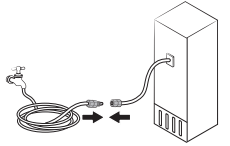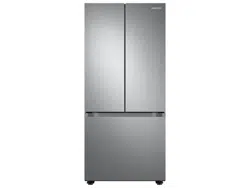Documents: Go to download!
User Manual
- Owner's manual - (English, French, Spanish)
- Energy Guide - (English)
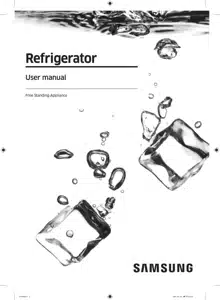
- Refrigerator at a glance
- Operations
- Maintenance
- Troubleshooting
Table of contents
User manual Refrigerator
Refrigerator at a glance
The actual refrigerator and provided component parts of your refrigerator may differ from the illustrations in this manual, depending on the model and the country
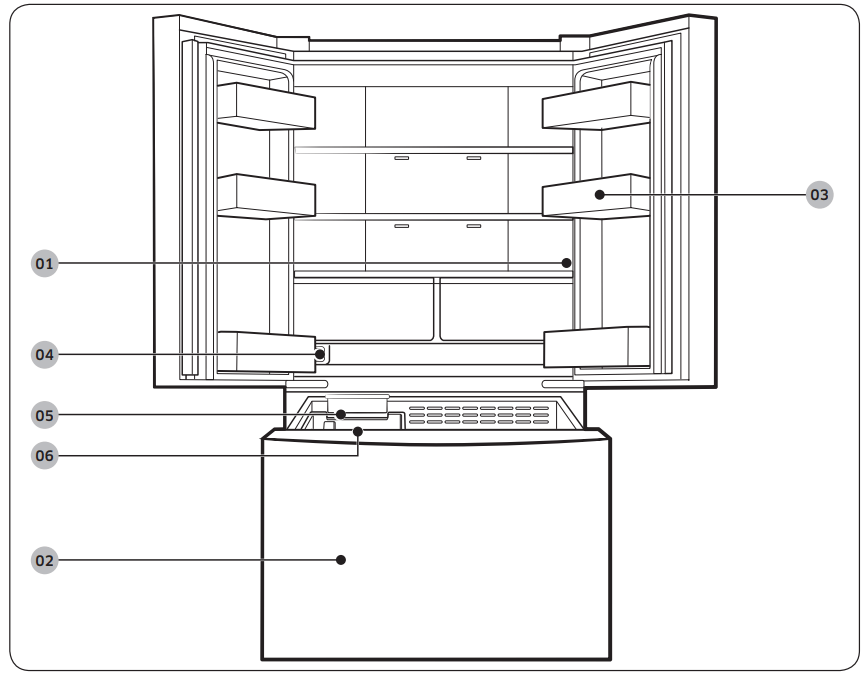
- Main panel
- Freezer
- Door bins
- Water filter
- Ice Maker *
- Ice bucket *
*Applicable models only
NOTE
- For energy efficiency, keep all shelves, drawers, and baskets in their original positions.
- When closing the door, make sure the vertical hinged section is in the correct position to avoid scratching the other door.
- If the vertical hinged section is reversed, put it back into the correct position, and then close the door.
- Moisture may form at times on the vertical hinged section.
- If you close a door forcefully, the other door may open.
- When a door is opened, the interlock switch automatically disables the auger motor of the ice maker for safety reasons.
- If the internal or external LED lamp is out of order, contact a local Samsung service center.
- If the door is left open for too long, the top internal LED will blink. This is normal.
Operations
Main panel
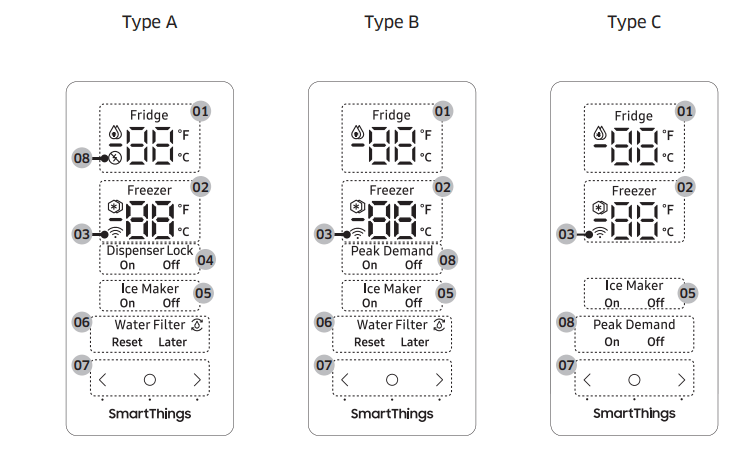
01 Fridge indicator
02 Freezer indicator
03 Network connection indicator
04 Dispenser Lock *
05 Ice Maker
06 Water Filter *
07 Buttons
08 Peak Demand *
* Applicable models only
NOTE
- When you change the temperature on the panel, the panel displays the actual temperature inside the refrigerator until the temperature matches the temperature you set. Then, the panel displays the new set temperature. Note that it will take time for the refrigerator to reach the new temperature. This is normal. During this time, you do not need to set the temperature again.
- To ensure optimal performance, we recommend setting the temperature to 0 °F (-18 °C) for the freezer, and 37 °F (3 °C) for the fridge.
- The temperature in the refrigerator may rise if you open the door frequently or put a large amount of food into the refrigerator. If this happens, the temperature display blinks until the refrigerator returns to the specified temperature settings.
- If a communication error occurs between the temperature display and the main controller, this blinking continues for an extended time. Contact a local Samsung service center for technical assistance.
- The display of the main panel turns on only if the door is opened and turns off if the door is closed.
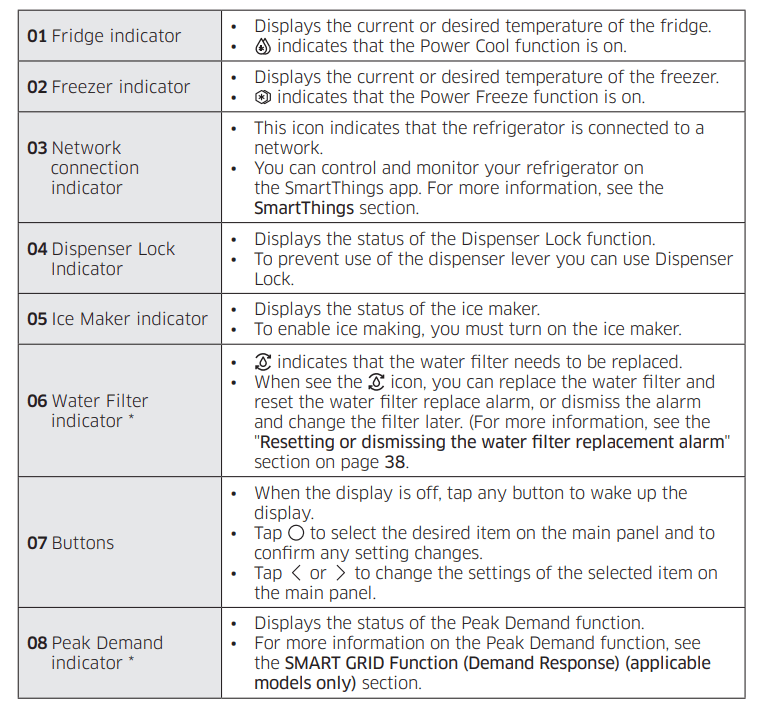
NOTE
- The control panel is designed to stay off when the refrigerator is not in use. It only becomes active and lights up when you open the door or tap the buttons.
- If the door is left open for 5 minutes, the internal light will blink for 5 minutes and turn off to alert deaf and hard of hearing users that a door is open. Note: that this function is normal
Setting the desired temperature or function
Select the fridge or freezer and set the desired temperature or function of your choice.
1.Tap any button (< , , > ) to wake up the display.
, > ) to wake up the display.
- This step may not apply to some models.
2. Tap  until the fridge or freezer indicator blinks.
until the fridge or freezer indicator blinks.
- The selected compartment’s indicator blinks.
3. Tap < or > to select the desired temperature or function.
- Refer to the table for available selection for each compartment.
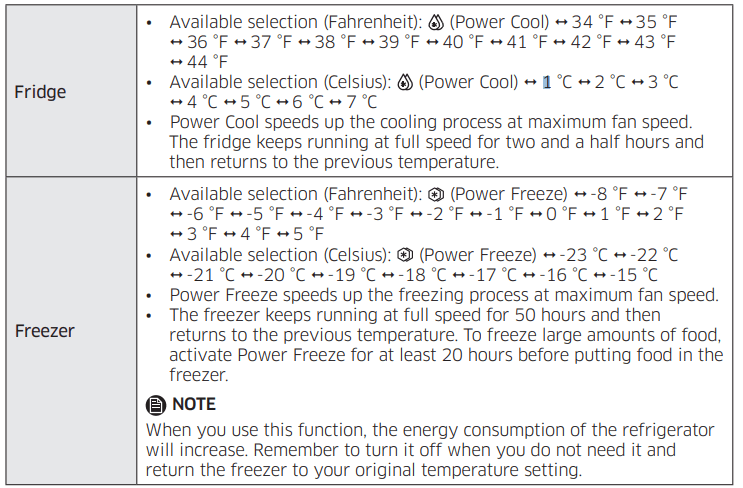
4. Wait for 5 seconds or tap  to confirm your selection.
to confirm your selection.
- The selected compartment’s indicator stops blinking.
NOTE
- Using Power Cool or Power Freeze increases power consumption.
- When you change the temperature on the panel, the panel displays the actual temperature inside the refrigerator until the temperature matches the temperature you set. Then, the panel displays the new set temperature. Note that it will take time for the refrigerator to reach the new temperature. This is normal. During this time, you do not need to set the temperature again.
- To ensure optimal performance, we recommend setting the temperature to 0 °F (-18 °C) for the freezer, and 37 °F (3 °C) for the fridge.
- The temperature in the refrigerator may rise if you open the door frequently or put a large amount of food into the refrigerator. If this happens, the temperature display blinks until the refrigerator returns to the specified temperature settings. If the blinking continues for an extended time, contact a local Samsung service center for technical assistance.
Changing the temperature scale
You can switch the temperature scale between Fahrenheit and Celsius.
- Tap any button (< ,
 , or > ) to wake up the display.
, or > ) to wake up the display.
- This step may not apply to some models.
- Tap
 until the °F and °C symbols on the fridge or freezer blink.
until the °F and °C symbols on the fridge or freezer blink. - Tap < or > to select the desired temperature scale.
- Tap < to select Fahrenheit.
- Tap > to select Celsius.
- Wait for 5 seconds or tap
 to confirm your selection.
to confirm your selection.
- The °F and °C symbols stop blinking.
Turning on or off the ice maker
You can turn on or off the ice maker in the freezer.
- Tap any button (< ,
 , or > ) to wake up the display.
, or > ) to wake up the display.
- This step may not apply to some models.
- Tap
 until the Ice Maker indicator blinks.
until the Ice Maker indicator blinks. - Tap < or > to turn on or off the ice maker.
- Tap < to turn it on.
- Tap > to turn it off.
- Wait for 5 seconds or tap
 to confirm your selection.
to confirm your selection.
- The Ice Maker indicator stops blinking.
Turning on or off the Dispenser Lock funtion
You can turn on or off the Dispenser Lock Function.
- ap any button (< ,
 , or > ) to wake up the display.
, or > ) to wake up the display.
- This step may not apply to some models.
- Tap
 until the Dispenser Lock indicator blinks.
until the Dispenser Lock indicator blinks. - Tap < or > toturn on or off the Dispenser Lock.
- Tap < to turn it on.
- Tap > to turn it off.
- Wait for 5 seconds or tap
 to confirm your selection.
to confirm your selection.
- The Dispenser Lock indicator stops blinking.
Resetting or dismissing the water filter replacement alarm
The water filter replacement icon (  ) blinks to alert the user that it is time to replace the water filter. You can replace the water filter immediately and reset the water filter replacement alarm, or dismiss the alarm if you want to change the water filter later.
) blinks to alert the user that it is time to replace the water filter. You can replace the water filter immediately and reset the water filter replacement alarm, or dismiss the alarm if you want to change the water filter later.
- Tap any buttons (< ,
 , or > ) to wake up the display.
, or > ) to wake up the display.
- This step may not apply to some models.
- Tap
 until the Water Filter indicator blinks.
until the Water Filter indicator blinks. - Tap < or > to select Reset or Later.
- If you have changed the water filter, tap < to reset the water filter replacement alarm.
- If you want to change the water filter later and dismiss the alarm, tap >.
- Wait for 5 seconds or tap
 to confirm your selection.
to confirm your selection.
- The Water Filter indicator stops blinking.
Turning on or off the Peak Demand function
Display Type A
You can turn on or off the Peak Demand Off (Override Mode) Function. For more information on the Peak Demand function, see the SMART GRID Function (Demand Response) (applicable models only) section.
- Tap any button (< ,
 , or > ) to wake up the display.
, or > ) to wake up the display.
- This step may not apply to some models.
- Press the button for 3 seconds, while not changing other display settings.
- When the Peak Demand Off function is deactivated, if you press < button for 3 seconds the Peak Demand Off function will be activated (
 ).
). - When the Peak Demand Off function is activated (
 ), if you press < button for 3 seconds the Peak Demand Off function will be deactivated.
), if you press < button for 3 seconds the Peak Demand Off function will be deactivated.
Display Type B, Type C
You can turn on or off the Peak Demand function. For more information on the Peak
Demand function, see the SMART GRID Function (Demand Response) (applicable models only) section.
- Tap any button (< ,
 , or > ) to wake up the display.
, or > ) to wake up the display.
- This step may not apply to some models.
- Tap
 until the Peak Demand indicator blinks.
until the Peak Demand indicator blinks. - Tap < or > to turn on or off the function.
- Tap < to turn it on.
- Tap > to turn it off.
- Wait for 5 seconds or tap
 to confirm your selection.
to confirm your selection.
- The Peak Demand indicator stops blinking.
Activating or deactivating the Sabbath mode (applicable models only)
The Sabbath mode stays active for 85 hours once it is activated. After that, it will be deactivated automatically.
- To activate or deactivate the Sabbath Mode, tap and hold
 and > simultaneously for 6 seconds. Then, when the display blinks, tap > .
and > simultaneously for 6 seconds. Then, when the display blinks, tap > .
- When the refrigerator is in the Sabbath mode, the buttons, display, and internal lights do not function. The refrigerator and freezer, however, continue to cool.
NOTE
- If the refrigerator powers off and restarts (for example, if there is a power failure), the Sabbath mode remains active. To end Sabbath Mode, you must deactivate it as instructed above
Activating or deactivating the Cooling Off mode
The Cooling Off mode (also called the Shop mode) is designed for retailers to display refrigerators on a retail floor. In the Cooling Off mode, the refrigerator’s fan motor and lights operate normally, but the compressors do not run, so neither the refrigerator nor the freezer becomes cold.
- To activate or deactivate the Cooling Off mode, tap and hold < and > simultaneously for 6 seconds. Then, when the display blinks, press
 .
.
- When the Cooling Off mode is on, the refrigerator chime sounds, and the refrigerator shows “0” on the fridge indicator and “FF” on the freezer indicator.
SmartThings
Installation
Visit the Google Play Store, Galaxy Store, or Apple App Store and search for “SmartThings”. Download and install the SmartThings app provided by Samsung Electronics to your smart device.
NOTE:
- The SmartThings app is not available for some tablet and iPad and some smartphone.
- Support that [Android] OS 8.0 or higher. (minimum 2 GB RAM Size)
- Support that [iOS] 12.0 or higher/iPhone 6 or higher.
- For improved performance, the SmartThings app is subject to change without notice or discontinued support according to the manufacturer's policy.
- Recommended encryption systems include WPA/TKIP and WPA2/AES. Any newer or non-standard Wi-Fi authentication protocols are not supported.
- In addition, further updates on the app or the function in the app may stop due to usability and security reasons, even if updates are currently supported on your OS.
- Wireless networks may be affected by the surrounding wireless communication environment.
- If your Internet service provider has registered the MAC address of your PC or modem for identification, your Samsung Smart Refrigerator may fail to connect to the Internet. If this happens, contact your Internet service provider for technical assistance.
- The firewall settings of your network system may prevent your Samsung Smart Refrigerator from accessing the Internet. Contact your Internet service provider for technical assistance. If this symptom continues, contact a local Samsung service center or retailer.
- To configure the wireless access point (AP) settings, see the user manual of the AP (router).
- Samsung Smart Refrigerators support both Wi-Fi 2.4 GHz with IEEE 802.11 b/g/n and Soft-AP protocols. (IEEE 802.11 n is recommended.)
- Unauthorized Wi-Fi wireless routers may fail to connect to applicable Samsung Smart Refrigerators.
Samsung account
You are required to register your Samsung account to use the app. If you don’t have a
Samsung account, follow the app’s onscreen instructions to create a free Samsung account.
Getting started
Turn on the device you want to connect, open the SmartThings app on your phone, and then follow the instructions below.
If a pop-up appears saying that a new device has been found, tap ADD NOW.
If a pop-up doesn't appear, tap the + button, and then select the device you want to connect from the list of available devices.
If your device isn't in the list of available devices, tap Supported Devices, select the device type (Refrigerator), and then select the specific device model.
Follow the instructions in the app to set up your device. Once setup is complete, your refrigerator will appear as a "card" on your Devices screen.
Refrigerator app
Integrated control
You can monitor and control your refrigerator at home and on the go.
- Tap the refrigerator icon on the SmartThings Dashboard or tap the Devices icon at the bottom of the Dashboard, and then tap the refrigerator "card" to open the Refrigerator page.
- Check the operation status or notifications related to your refrigerator, and then change options or settings if necessary.
NOTE Some options or settings of the refrigerator may not be available for remote control.
Refrigerator settings
|
Category |
Item |
Description |
|
Monitoring |
Fridge temperature Displays the desired temperature setting of the fridge. Freezer temperature Displays the current temperature of the freezer. Diagnosis Detects abnormal operations of the refrigerator. Energy monitoring Checks the accumulated power consumption of the refrigerator for the last 180 days. Ice making You can turn the ice making function on or off, and check the current settings of the function. You can also check the status and progress of ice making. Power Cool You can turn Power Cool on or off, and check the current settings. Power Freeze You can turn Power Freeze on or off, and check the current settings. Fridge temperature You can set the desired temperature of the fridge. Freezer temperature You can set the desired temperature of the freezer. Sabbath Mode You can activate and deactivate the Sabbath mode. Abnormally high temperature This alarm is triggered when the fridge or the freezer has abnormally high temperatures. Door opening This alarm is triggered if the fridge door or the freezer drawer is open for a specific time. Water filter replacement This alarm reminds you that the water filter must be replaced. |
|
|
Functions |
||
|
Alarms |
||
SMART GRID Function (Demand Response) (applicable models only)
When the refrigerator operates in SMART GRID (Demand Response) mode, the Energy Management Refrigerator function can control energy usage or delay the operation of some functions to save money when energy prices or demand are the highest.
NOTE
- You can deactivate the SMART GRID (Demand Response) function at any time using the Peak Demand Off function.
- To use the SMART GRID (Demand Response) function, you need a separate contract with your electric utility company.
In addition, to use the Smart Grid (Demand Response) function, you must register for the service with your electric company. The company must have an EMS (Energy Management System) that supports SEP (Smart Energy profile).
Using the SMART GRID (Demand Response) Function
This feature monitors energy prices and demand information from your utility company and sends notifications to the refrigerator to run high energy consuming tasks during off-peak times when electricity costs and demand are lower.
If the refrigerator receives a control signal from the utility company, the refrigerator will display the DAL (L3) ~ TALR (L4) levels on the refrigerator display and control the power consumption according to the level.
[Exception condition] The DAL and TALR control signals from a utility company work as long as product performance is maintained.
If the refrigerator receives the SMART GRID (Demand Response) signal (DAL or TALR), the refrigerator will operate in Delay Appliance Load (Display:L3) or Temporary Appliance Load Reduction (Display:L4) mode.
- Delay Appliance Load (L3): The refrigerator responds to a DAL signal by providing a moderate load reduction for the duration of the delay period. This function controls functions that consume a lot of energy such as adjusting the Cooling system, running the defrost cycle, and making ice.
- When the refrigerator operates in DAL (L3) mode, “L3” is displayed on the refrigerator display.
- DAL mode is automatically deactivated after it lasts for the amount of time stipulated by the DAL signal (max. 4.5 hours) or when the Peak Demand Off key is pressed.
- Temporary Appliance Load Reduction (L4): The refrigerator responds to a TALR signal by aggressively reducing the load for a short time period. This function reduces energy consumption by stopping the compressor and controlling the functions that consume a lot of energy such as the defrost cycle and making ice.
- When the refrigerator operates in TALR (L4) mode, “L4” is displayed on the refrigerator display.
- TALR (L4) mode is automatically deactivated after it lasts for the received duration (max. 15 minutes), or when the Peak Demand Off key is pressed. The mode is immediately deactivated and the refrigerator returns to the normal state when the door is opened or closed, or the dispenser is used.
Peak Demand Off (Override mode)
When you want the refrigerator to ignore the SMART GRID (Demand Response) signal from the utility company, you can activate Peak Demand Off (Override mode).
When you activate Peak Demand Off (Override mode), the refrigerator ignores the SMART GRID (Demand Response) signal and is not controlled by the utility company.
Activating and deactivating Peak Demand Off (Override mode)
Display Type A
- To activate/decativate Peak Demand Off (Override mode), Press the < button for 3 seconds, while not changing other display settings.
- When the Peak Demand Off function is deactivated, if you press < button for 3 seconds the Peak Demand Off function will be activated.
- The corresponding indicator (
 ) turns on.
) turns on. - If the refrigerator receives a SMART GRID (Demand Response) signal from the utility company, ‘Or' is displayed in the fridge indicator.
- The corresponding indicator (
- When the Peak Demand Off function is activated, if you press < button for 3 seconds the Peak Demand Off function will be deactivated.
- The corresponding indicator (
 ) turns off.
) turns off.
- The corresponding indicator (
Display Type B, Type C
- To activate Peak Demand Off (Override mode), tap
 until the Peak Demand indicator blinks.
until the Peak Demand indicator blinks. - Tap > to select the Peak Demand Off.
- The corresponding indicator (Peak Demand Off) turns on.
- If the refrigerator receives a SMART GRID (Demand Response) signal from the utility company, ‘Or' is displayed in the fridge indicator.
- To deactivate Peak Demand Off (Override mode), tap
 until the Peak Demand indicator blinks.
until the Peak Demand indicator blinks. - Tap < to select the Peak Demand On.
- The corresponding indicator (Peak Demand On) turns on.
Using the Energy Management Function
The Energy Management function enables you to control and monitor your Energy Management refrigerator using the SmartThings app for your convenience.
NOTE
- To use the Energy Management refrigerator functions, you have to install the corresponding app first.
- Operational Status
- You can check the DR and Peak Demand Off (Override mode) status.
- Energy Consumption Reporting
- Shows the accumulated power consumption. Power consumption data is updated every 10 minutes.
NOTE The energy consumption report may differ from the power consumption specifications of the product depending on the operating environment and the stored food.
- Shows the accumulated power consumption. Power consumption data is updated every 10 minutes.
- Delay Defrost Capability
- The Delay Defrost Capability function saves energy by delaying the defrost operation to a time specified by the user. You can configure the time. And this function will save energy during the specified period in a 24 hour cycle. If the time is not set, the function works with the default time settings. The default time settings are below:
- 6 am to 10 am: 1st. November ~ 30th. April
- 3 pm to 7 pm: 1st. May ~ 31th. October
To change the time setting for the Delay Defrost Capability
You can change the time setting for the Delay Defrost Capability on the app.
Provision for Open Access to the Connected Product Requirements
- SGIP Open Standards (Smart Energy Profile 2.0 - http://www.csep.org/)
- Energy Consumption Reporting
- Demand Response
- Samsung OPEN API
- Operational Status, User Settings & Messages
- ICE Maker Status: GET /icemaker/status/vs/0
- Door Open Alarm: GET /doors/vs/0
- DR Status: GET /drlc/vs/0
- Delay Defrost Capability
- Set Schedule of the Defrost Delay: POST /defrost/reservation/vs/0?op=add
- Get Schedule of the Defrost Delay : GET /defrost/reservation/vs/0
- Delete Schedule of the Defrost Delay: POST /defrost/reservation/vs/0?op=remove
- Defrost Delay On/OFF: POST /defrost/delay/vs/0
Special features
Water dispenser
Using the dispenser, you can dispense water.
To dispense chilled water, turn off the Dispenser Lock function. Put a water glass under the dispenser, and then push the dispenser lever.
NOTE
- The dispenser will stop dispensing if you keep pushing the dispenser lever for about 1 minute. To dispense more water, release and push the lever again.
- Make sure the glass is in line with the dispenser to prevent the dispensed water from spilling out.
- If you do not use the water dispenser for 2-3 days, the dispensed water may have an abnormal smell or taste. This is not a system failure. Discard the first 1-2 glasses of water.
Water clouding
Water supplied to the refrigerator flows through a core alkaline filter. During this filtering process, the water pressure of the water increases and the water becomes saturated with oxygen and nitrogen. This causes the water to look misty or cloudy temporarily when dispensed. This is normal and the water will look clear after a few seconds.
Maintenance
Handling and care
Shelves
CAUTION
- The shelf must be inserted correctly. Do not insert upside down.
- Glass containers may scratch the surface of glass shelves.
Fridge shelves
- Fully open the fridge door.
- Hold the front of the shelf lift the back of the shelf to release the hook from the groove.
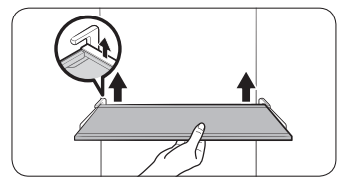
- Hold the front and back of the shelf. Lift the back of the shelf, and then pull it out.
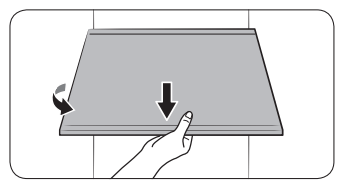
Vegetable shelves

- Fully open the fridge door.
- Lift up the front of the shelf and pull it to release the shelf from the holder at the rear wall.
CAUTION Be careful not to knock on the doors.
Door bins
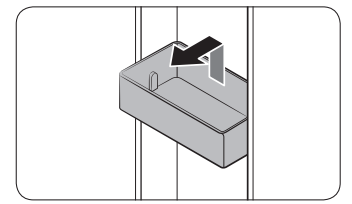
- To remove the door bin, hold the front sides of the bin, and then gently lift up to remove.
- To reinsert, insert the door bin slightly above its final location making sure that the back of the bin is against the door. Hold the rear of the door bin with both hands, and then press down so that it fits snugly.
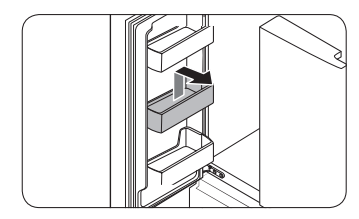
CAUTION
- Do not remove a bin that is filled with food. Empty the bin beforehand.
- Use caution when opening the door if the bottom bin contains larger bottles, which may fall over.
- Do not allow children to play with the bins. Sharp corners of the bin may cause injury
Fridge drawers
Vegetable / fruit drawers

Gently lift up the front of the drawer and slide out.
- We recommend that you remove the door bins before removing the drawer. This is to prevent damage to the door bins.
- To reinsert, insert the drawer into the frame rails and then slide inward.
Freezer baskets
Lower ice bucket (applicable models only)
- Fully open the freezer drawer.

- Lift the lower ice bucket to remove.
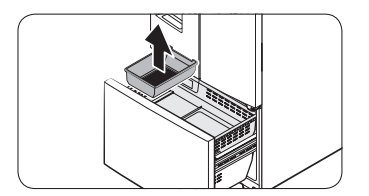
Upper basket
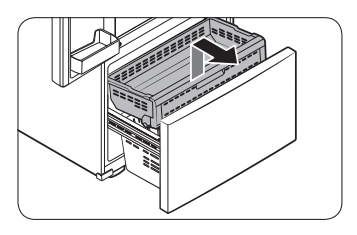
- To remove, fully slide open the freezer drawer. Lift up the front of the upper basket and pull to remove.
- To reinsert, align the front wheels of the upper basket with the end of the lower basket. Slide the upper basket to the front
NOTE Keep the refrigerator door fully open.
Lower basket
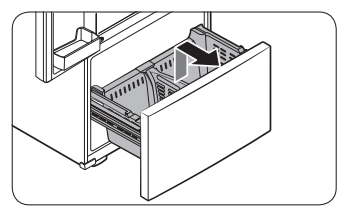
- To remove, first remove the upper basket. Then, tilt up the front of the lower basket to pull out.
- To reinsert, put the basket onto the rail assembly rear side first.
CAUTION
- Do not twist the basket when removing or reinserting the basket. The basket can be scratched.
- To prevent physical injury, property damage, or suffocation, keep children away from freezer baskets that have been removed.
- Do not remove the divider.
- Put the wheels of the upper basket on the end of the rails of the lower basket. Then, slide the upper basket all the way to the front. Otherwise, the drawer will not open or close properly, which will cause frost to build up.
Cleaning
Interior and exterior
WARNING
- Do not use benzene, thinner, home/car detergent, or Clorox™ to clean the refrigerator.
They may damage the surface of the refrigerator and cause a fire. - Do not spray water onto the refrigerator. This may cause electric shock.
Regularly use a dry cloth to remove all foreign substances such as dust or water from the power plug terminals and contact points.
- Unplug the power cord.
- Use a moistened, soft, lint-free cloth or paper towel to clean the refrigerator’s interior and exterior.
- When done, use a dry cloth or paper towel to dry well.
- Plug in the power cord.
Rubber seals
If the rubber seals of a door become dirty, the door may not close properly and reducing refrigerator performance and efficiency. Use a mild detergent and damp cloth to clean the rubber seals. Then, dry well with a cloth.
Rear panel

To keep cords and exposed parts of the rear panel free of dirt, vacuum the panel once or twice a year.
CAUTION Do not remove the rear panel cover. Electric shock may occur.
Replacement
Water filter
WARNING
- Do not use third-party water filters. Use only Samsung-provided or -approved filters.
- Unapproved filters may leak and damage the refrigerator, causing electric shock. Samsung is not responsible for any damage that may occur from use of third-party water filters.
The Water Filter Indicator ( ) turns red to let you know it is time to replace the water filter. Before replacing the filter, make sure the water supply line is shut off.
) turns red to let you know it is time to replace the water filter. Before replacing the filter, make sure the water supply line is shut off.
- Shut off the water supply line.
- Turn the knob of the filter cartridge 180 degrees counterclockwise (1/4 turn). The filter cartridge unlocks.
See other models: RF22A4121SG/AA RT16A6195SR/AA QN85Q7DTAFXZA WW95T754DBT WW85T754DBT

- Pull out to remove the cartridge.
- If the water filter is severely contaminated, the cartridge may not be easy to remove. If that is the case, use force to remove the cartridge.
- To prevent water leaks from the filter opening, pull the cartridge straight out while removing it.
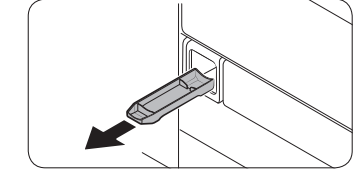
- Insert a new filter cartridge. Use only Samsung-provided or approved filters.
- Turn the cartridge knob clockwise to lock into place.

- Tap
 button until the Water Filter Indicator (
button until the Water Filter Indicator ( ) blinks. And then tab < or > to turn on Reset and then tab
) blinks. And then tab < or > to turn on Reset and then tab  to confirm.
to confirm. - When you are done replacing the filter, open the water valve and run water through the dispenser for about 7 minutes. This is to remove impurities and air from the water line.
NOTE
- A newly installed filter may cause the water dispenser to spurt water briefly. This is because air has entered the waterline.
- The replacement process may cause the water dispenser to drip for a short period of time. If it drips, simply wipe up any water on the floor with a dry towel.
Reverse osmosis water filtration system
The water pressure of the water supply system to a reverse osmosis water filtration system must be between 30 to 120 psi (206 to 827 kPa).
The water pressure of the reverse osmosis water filtration system to the refrigerator’s cold water line must be at least 40 psi (276 kPa). If the water pressure is below these specifications:
- Check if the sediment filter in the reverse osmosis system is blocked. Replace the filter if necessary.
- Refill the water tank in the reverse osmosis system with water.
- If your refrigerator has a water filter, it may further reduce the water pressure when used in conjunction with a reverse osmosis system. Remove the water filter.
For more information or servicing, contact a licensed plumbing professional.
Ordering a new filter
To purchase a new water filter, contact a local Samsung service center or visit www. samsungparts.com on the web.
LED Lamps
To replace the lamps of the refrigerator, contact a local Samsung service center.
WARNING The lamps are not user-serviceable. Do not attempt to replace a lamp yourself. This can cause electric shock.
Troubleshooting
Before calling for service, review the symptoms and recommended solutions below. If none of the suggested solutions resolve your problem, please visit our website or call Samsung Customer Care at 1-800-SAMSUNG (726-7864). Note: that you will be charged for any service visits in which no defects were found.
General
Temperature
|
Symptom |
Possible causes |
Solution |
|
Fridge/freezer does not operate. Fridge/freezer temperature is warm.
|
|
|
|
|
|
|
|
|
|
|
|
|
|
|
|
|
|
|
Fridge/freezer is over-cooling. |
|
|
| Interior wall is hot |
|
|
Odors
|
Symptom |
Possible causes |
Solution |
|
Refrigerator has odors. |
|
|
|
|
Frost
|
Symptom |
Possible causes |
Solution |
|
Frost around the vents. |
|
|
|
Frost on interior walls. |
|
|
Condensation
|
Symptom |
Possible causes |
Solution |
|
Condensation forms on the interior walls. |
|
|
|
|
Water/ice (dispenser models only)
|
Symptom |
Possible causes |
Solution |
| Water flow is weaker than normal. |
|
|
| Ice maker makes a buzzing sound. |
|
|
| Ice maker does not make ice. |
|
|
|
|
|
|
|
|
|
|
|
| Water does not dispense. |
|
|
|
|
|
|
|
|
|
|
Do you hear abnormal sounds from the refrigerator?
Before calling for service, review the information below. If you still have questions about sounds your refrigerator is making, please call Samsung Customer Care at 1-800-SAMSUNG (726-7864). Note: that you will be charged for any service visits related to normal operating sounds in which no defects were found.
These sounds are normal.
- When starting or ending an operation, the refrigerator may make sounds similar to a car engine ignition. As the operation stabilizes, the sounds will decrease.
- While the fan is operating, these sounds may occur. When the refrigerator reaches the set temperature, the fan sound will stop

- During a defrost cycle, water may drip on the defrost heater, causing sizzling sounds

- As the refrigerator cools or freezes, refrigerant gas moves through sealed pipes, causing bubbling sounds.

- As the refrigerator temperature increases or decreases, plastic parts contract and expand, creating knocking noises. These noises occur during the defrosting cycle or when electronic parts are working.

- For ice maker models: When the water valve opens to fill the ice maker, you may hear a buzzing sound.
- Due to pressure equalizing when you open and close the refrigerator door, you may hear a whooshing sound.
SmartThings
|
Symptom |
Action |
|
Could not find “SmartThings" in the app market. |
|
|
The SmartThings app fails to operate. |
|
|
The SmartThings app is installed but is not connected to my refrigerator. |
|
|
Could not log into the app. |
|
|
An error message appears when I try to register my refrigerator. |
|
|
The SmartThings app is successfully connected to my refrigerator but does not run. |
|
Smart Grid
|
Symptom |
Action |
|
What Do I Need to use the Energy Management and Smart Grid functions? |
You also need to:
|
|
Why isn't the Energy Management function working normally? |
- Connect a Smartphone to the router (AP, Access Point), and then confirm that you can browse the Internet on the phone.
- Check for Wi-Fi icon on the panel of the refrigerator. If the refrigerator is connected, the icon will be on.
|
|
Why isn't the Delay Defrost Capability working normally? |
|
